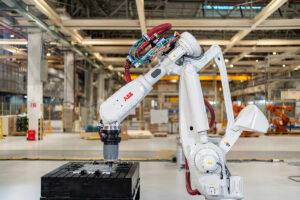By Milwaukee Tool, Contributor
It is critical that construction workers be equipped with state-of-the art head protection. Designed to provide better and more comprehensive impact protection, Type 2 safety helmets have become increasingly popular as technologies have evolved to ensure improved worker safety and productivity on the jobsite.
Recognizing their benefits, the Occupational Safety and Health Administration has recently recommended Type 2 safety helmets as the preferred form of protection for construction workers. A growing number of construction companies have followed suit and are now requiring their workers to make the switch.
The need for innovative head protection is as great as ever in the construction industry.
The Importance of Safety in Construction
There is no higher priority than worker safety in construction. Additionally, the safety, health, and wellbeing of workers are essential to ensuring a project is executed efficiently, on-time, and within budget.
The High Risk of Traumatic Brain Injuries in Construction
The need for innovative head protection is as great as ever in the construction industry.
One of the greatest hazards the construction workforce faces is the extraordinarily high risk of both fatal and nonfatal occupational traumatic brain injuries (TBIs).
Research shows that of all industries in the United States, construction regularly experiences the most TBIs, accounting for one in four of all such incidents. In 2022, there were 423 fatalities on jobsites caused by a slip, trip, or fall, according to the Bureau of Labor Statistics.
Most Traumatic Brain Injuries are the Result of a Fall
Construction workers have traditionally worn Type 1 head protection, as it provides top-of-the-head protection against objects or debris that fall from above. However, they are less effective at protecting the sides of the head against damage caused by a slip, trip, or fall.
Yet research has shown that falls are responsible for nearly 70% of all TBIs in the workplace.[1] Research has also revealed that between the two options, Type 2 head protection is the most effective at reducing the occurrence and severity of work-related TBIs.[2]
The Improved Protection of Type 2 Safety Helmets
Compared to Type 1, Type 2 head protection is explicitly designed to provide a higher level of protection against TBIs in compliance with national safety standards such as the American National Standards Institute (ANSI). This Type 2 standard rating indicates greater protection to the top and side of the user’s head.

Construction companies and workers must embrace new technologies that provide enhanced protection.
Some Safety Helmets Protect Against Oblique Impacts
In addition to damage to the top and sides of the head, TBIs from slips, trips, and falls can be caused by what’s called an “oblique impact”. A combination of both linear and rotational forces, oblique impacts require more advanced forms of protection than a hard hat or even a baseline safety helmet can provide.
However, some safety helmets incorporate new technologies designed to specifically protect against oblique impacts. One example is the BOLT Safety Helmet with IMPACT ARMOR
Safety Helmet with IMPACT ARMOR Liner by Milwaukee Tool, which features RHEON
Liner by Milwaukee Tool, which features RHEON technology, a padded interior layer of energy-absorbing polymers. The BOLT
technology, a padded interior layer of energy-absorbing polymers. The BOLT Safety Helmet with IMPACT ARMOR
Safety Helmet with IMPACT ARMOR Liner provides the best oblique impact protection†, even in comparison to competitive advanced safety helmets.
Liner provides the best oblique impact protection†, even in comparison to competitive advanced safety helmets.
†Based on impacts at a 45 degree angle at a speed of 6.5 m/s averaged across 16 testing locations around the full helmet circumference.
Safety Helmets Have Chin Straps
Another protective advantage of safety helmets is how well secured they are to the user’s head. Many safety helmets incorporate chin straps and suspension systems that ensure the helmet will remain securely in place in the event of a slip, trip, or fall. Akin to climbing helmets in this way, the secure design of safety helmets also allows for work at high heights, making them particularly compatible with the needs of electrical and other utility workers.
Safety Helmets Can Be Accessorized
Some safety helmets are designed to allow users to mount various safety accessories depending on their needs, including face-shields, visors, hearing protection, head lamps, and marker clips. Though some models allow for personalization, most traditional hard hats are limited in their personalization options.
Bottom Line
Construction is a dynamic industry where workers are routinely exposed to hazards that put them at increased risk of injury and death. To mitigate these hazards, workers and construction companies must embrace new technologies that provide enhanced protection on the jobsite.
The Type 2 ANSI rating in combination with additional features like chin straps, advanced material liners, and other safety accessories make safety helmets the best option for construction workers seeking improved protections against slips, trips, and falls on the jobsite.
Milwaukee Tool is a manufacturer of heavy-duty power tools, hand tools, instruments, and accessories (milwaukeetool.com).
[1]
[2]
The post Head Protection is Evolving – Are You? appeared first on Workplace Material Handling & Safety.




